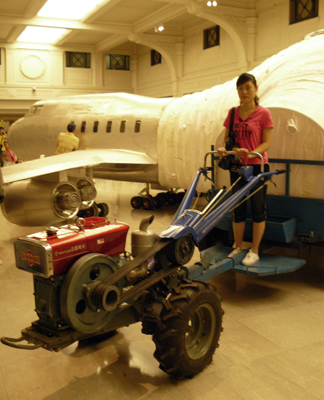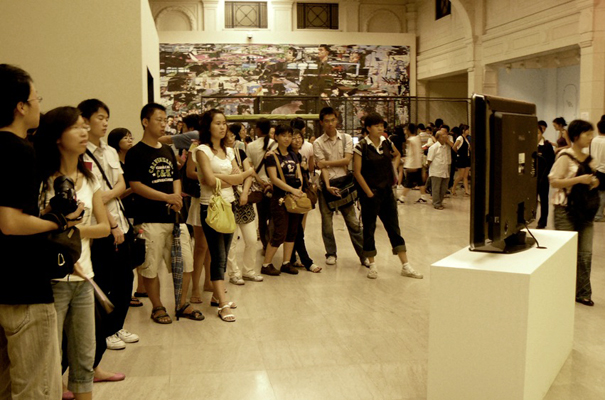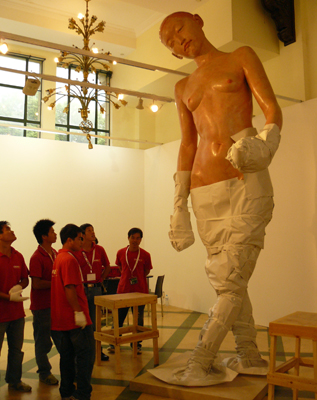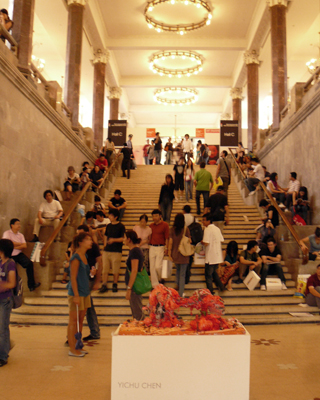Double dip: The Asian Biennale and Art Fair

First published in TASSA Review’s 20th Anniversary Issue – 2013 (Australia).
There are over 80 international biennials and triennials today, an overwhelming number of which began during the 1990s; 25 of them held in Asia. (1.) These events not only brought significant international art and artists to Asian cities, but also fostered a new regional contemporary art identity, first through an awareness of localized activities and secondly by uniting artists and providing a platform for dialogue on shared issues.
Between 2000-08 the number of Asian biennales doubled parallel to Asia’s growing prosperity. If you add the growth of art fairs across East, South and Southeast Asia – a staggering 35 new fairs since 2000 and counting – the numbers collectively say more about these individual locations than the art they are showing. As the sociologist Pascal Gielen (2009) observes:
The biennale,“…fits easily in a neo-liberal city marketing strategy of so-called ‘creative cities’.”
Most of Asia’s biennales are funded by governments eager to promote themselves as developed cultural destinations; increasingly aware of their own market globility. New museums devoted to contemporary art have sprung up across Asia, unheard of ten years earlier, many of them linked to or hosting these biennales. Governments are offering tax incentives and attractive packages for international galleries to choose their art fair over others or are invested in these enterprises as key stakeholders, such as Singapore’s Art Stage significantly backed by the Economic Development Board and Singapore Tourism Board.
These composite activities have emerged as an intoxicating cultural/economic cocktail answering a local hunger parallel to a global enchantment for the market brand of ‘Contemporary Asian art’. It has even been touted that the art fair is the new biennale within Asia, perhaps more comfortable with the kind of consumerist expansionism at play.
Clearly the circuits of recognition and distribution have shifted. In the past it was about the ‘arrival’ of an Asian modernity within the international museum frame; now it is the affirmation of an extremely diverse and articulate contemporary Asian art directed largely from within and speaking a new language of cultural tourism and economics. Benson Puah of Singapore’s National Art Council concurs, “…art and culture can also be the lubricant and the genesis of an economically vibrant and cultured society.” (Kolesnikov-Jessop 2010)
To understand this new ‘geography’ we need to step back to the historical platforms that define the biennale model. We know the biennale was born with Venice in 1895, however, its pedigree or Euro-centricity is not of interest here; rather its roots as a tourism initiative of-the-day offers the greater legacy to the Asian biennale. Korean critic Jinsang Yoo makes the alert observation, “Global politics and economies are already being led by cities, not countries…Therefore, it has become important for local cities to enhance brand values and showcase their original cultural capacities. The most effective tool for them is contemporary art, which is a kind of common language that enables universal understanding and satisfies cultural and intellectual demands of both the East and the West.” (Yoo 2008:60)
In understanding this new model of the Asian biennale we need to recognise that the traditional Western curatorial model was based on the paradigm of ‘nation’. In our times of Post-nation existence regional inflections or nodes of productivity increasingly define culture. I suppose the simple analogy is the fake Louis Vuitton handbag, its signature design embraced, appropriated, and morphed into a version that it more reflective of local tastes and aspirations than its ‘native’ self.
It indicates where these art scenes are setting their sights. Several of these Asian biennales have shifted from local survey exhibitions to become International multi-dimensional events turning towards global trends. Shanghai, Guangzhou, Taipei, Busan, Gwangju, and Yogyakarta have all made this shift, the most recent the 2009 Jakarta Biennale despite starting in the 1960s as a painting show. Speaking with Indonesian curator Ade Darmawan he made the point, “This international context is very important for us because we are inviting, not just being invited. We need to see ourselves in a global context.” Singapore’s latest biennale Open House (2011) is case in point to the biennale’s growing ‘Asianness’, with 27 of the 63 participating artists hailing from Asia, situating the local firmly in the global.
This adaptation is taking place with extraordinary rapidity and flexibility. Visiting the Shanghai Biennale I was astounded to see crowds snaking their way around the museum waiting to get in just days after SHcontemporary art fair hit record attendances. One can only surmise that the biennale audience today sits primarily outside the vernissage art caravan and, in China in particular, addresses an imploding domestic tourism industry. What currency, then, does the voice of the ‘super-curator’ have to this local population where he or she steps centre stage for a short moment to then disappear? It is a swift shift from art world rhetoric to mobile-phone-moments snapped with ’the art’, later to be posted on Facebook, the local quickly usurping ownership of the event once the art entourage has passed. It is a very Asian sensibility.
Visitor posing for photo with Yin Xiuzhen’s installation at 7th Shanghai Biennale 2008, China Photograph Gina Fairley
Mobile phone documentation by public at 7th Shanghai Biennale 2008, China; Photograph Gina Fairley
What has struck me repeatedly visiting Asia’s Biennale are the numbers clustered around the video installations, diligently watching them from start to finish. They are hungry for this media. Technology functions as a universal language that enables communication across geography, ethnicity, age and religion and, for this singular reason, affirms its place within the biennale genre. Further, it indicates a growing affluence within Asian localities; mobile phones and computers are ubiquitous today. The medium itself offers the entry point to engagement rather than a curatorial premise.
Shanghai Biennale 2008
It is an interesting consideration, this parallel of technology flavoring how art is made with the biennalisation of Asia. Curator of the 2004 Gwangju Biennale, Yongwoo Lee, believes other factors are also at play. “The biennale culture of Korea has already accumulated 13 years of experience and is constantly expanding, quantitatively. I do not believe that it comes from the system of the biennale or structure of global production it conveys…I anticipate the emergence of a new ideology and international styles of art in the niches of the economic crisis and recess.” (Lee 2009:88))
Lee believes the needs and local desires of individual nations are driving this beast. Take China for example. Before 1996 it didn’t have a single biennale; it reportedly now has seven. ArtZineChina reports, “Four years ago there was only one art district – the 798 in Beijing; now seven cities around this country have art districts and Beijing alone enjoys nine art districts…Art Galleries grew from less than 30 five years ago to at least 300 at present…70% of all [Chinese] collectors have emerged in only the last two years.” (Gi 2008:158)
This explosion is not specific to China. Between 2006 and 2008, the number of art fairs across Asia multiplied as rapidly as the prices for the art itself. Over 50 major fairs where held in 2008 and 21 of those were hosted by Asian cities. Former Art Asia Pacific Editor Andrew Maerkle (2009:88) notes that, “…galleries from the Asia Pacific region still represent less than 1% of international art fair exhibitors.” While this statistic may be true it does not reflect the number of Asian artists shown at these events regardless of the location of the gallery.
As the price of Asian art continues to escalate, the world sits eagerly speculating if, and when, the bubble with burst. If the impact of the Global Economic Crisis, and the more recent economic dip continue to be weathered by these events, that will be the real barometer to their sustainability as the new curatorial model. As the market potentially recedes, local popular interest in contemporary art continues to have a ferocious appetite across Asia sustaining the phenomenon. How these biennales and fairs morph and fuse to cater to popular demands and intone their western formulaic frame with local relevancy and a sense of witness to development will be watched with great interest globally.
Two ways already proving successful in staging these dialogues is the use of the satellite venue and bringing the biennale closer to the art market. Using raw (un)familiar sites has increasingly become a marketing chip to identifying and growing biennales to local and international audiences. They usher the pedestrian public to a more level playing ground, a place unfamiliar to us all and yet one that carries the residue of a city: its history, its collective memory, its trade and contemporary gentrification.
For example, the inaugural Singapore Biennale (2006) used religious sites under its theme Belief stating it was taking contemporary art to places that were comfortable and familiar for locals. The Third Guangzhou Triennial (2008) chose a half-built residential development in the commuter suburb of Guangdong, and XIII Jakarta Biennale (2009) located artworks within the ritzy Western-styled Grand Indonesia Mall, commenting on the profusion of Asian mall-culture and the commodification of art. What these satellite sites say about the development and embedding of these art events within their own communities is a more revealing conversation than the artworks themselves that collectively take on ‘biennale sameness’. Today this very locality is key to growing biennales rather than the antiquated concept of the nation-based survey.
Such tactics, then, beg the question what is the more accurate narrative: the contemporary reality of the site or the reality constructed by the artworks? One might even ask whether the biennale has become so thoroughly massaged and hyped that it has backed itself into a corner of staged dialogues allowing art fairs to fill the fissures.
Layer that with the trend to package these exhibitions with other events and, understandably, their critical edge starts to blur. It pivots on the marketing concept of ‘added value’ where the sincere idealism of curatorial themes has been sidelined by opportunism. Is this simply an equation of accountability in today’s climate where funding sponsors and governments hold the ultimate strings? Or is it a more astute understanding of their primary audience post-vernissage?
It is not surprising that “The commercial art world lurks in the shadows of biennales, since they are sites where reputations are established…[on the other hand] relatively few curators have a detailed knowledge of more than one part of Asia and thus are rarely in a position to ‘discover’ relatively unexposed artists.” (Clarke 2002:45) The art fair conveniently timed alongside the biennale opens up, exponentially, the profiling of emergent talent, a kind of one-stop-shop of now.
Jack Tilton Gallery packing up Xiang Jing’s sculpture “And You?” (2005) Painted fibreglass 163 x 60 x 64.5 inches; SHcontemporary08 art fair, Shanghai; Photograph Gina Fairley
The most obvious is Art Basel with the Venice Biennale, which started the trend. Art Dubai coincides with Sharjah Biennale, SHContemporary opens within days of Shanghai Biennale, the 4th Korean International Art Fair changed its dates to relate to three major biennales: Gwangju, Busan and the Seoul International Media Art Biennale, and Christie’s began its week of Asian auctions on the heels of Art HK11 holding its contemporary sale just hours after the fair closed. And if the boundaries weren’t blurred enough “…the Swiss MCH Group organizers of Art Basel and Art Basel Miami Beach announced that they have acquired a majority stake in Art HK” (AAP Editors 2011:39) The competitive jostling between these events has become manic and, with the in-bed advantage assigned to biennale curatoriums of the past flowing into art fairs as the real geographic power-brokers of the day, Asia is at the forefront of this push.
What is perhaps more interesting than these power structures, is the way art fairs are redefining themselves with curated components and commissioned works by ‘celebrity artists’ featured within their selling halls. SHContemporary’s Best of Discovery says it all; its name playing off the speculation that has skewed the market and blatantly hijacking the biennale’s platform for announcing ‘the state of now’. Art Stage Singapore in its inaugural edition this year was rumored to have muscled exhibitors in what they showed under the auspices of presenting a curatorially fresh fair. Similarly Asia’s hottest fair of the moment, Art HK, presented Asia One, a new section made up of 47 galleries from Asia presenting solo shows of Asian artists as well as its Art Futures section, which had grown to include 45 newly established galleries.
SHcontemporary08 art fair, Shanghai
With its attendances up 38% on last year, it ratchets up the old competitive challenge to Singapore vying for the position as Asia’s leading cultural hub. Both cities are heavily invested in this position with what could be described in marketing terms as ‘a mix’ of museums, arts fairs, biennales, auctions, and education – a billion dollar investment. Hong Kong’s high hopes for its new cultural district of West Kowloon and contemporary museum M+ aligned with Singapore’s Economic Development Board’s Creative Services Development Plan, its new FreePort (a government developed free-trade zone dedicated to high-end art storage), and The National Art Gallery of Singapore (TNAGS) scheduled to open in 2015, are challenging China’s success in catching the global eye.
How do we navigate this cultural expansion contest? It has become virtually impossible to accurately map this landscape due to its pace and spread but, more alarmingly, to assess it with a level of criticality. Reviews remain trained on established international events and with the lack of art critics on the ground in Asia to gauge these events within the climate of global trends, as well as their currency with local and regional audiences, the greater danger is not the economic burn-out of these events but rather our inability to assess contemporary Asian art outside the endorsement of the market. Curiously the New York magazine Art Asia Pacific is the primary media sponsor for the majority of these fairs, attaching itself as a marketing opportunity. I return again to the fake Louis Vuitton handbag and the question, is what we are witnessing real or what we are told the more real?
Essay note:
- The Asian Art Archive in Hong Kong has done the most extensive survey of Asian Biennales, published in 2008 as a research portal; German-based Universes in Universe equally have consistently documented these events for several years, images dialogue of which are published by Dr. Gerhard Haupt & Pat Binder.
References:
AAP Editors 2011 ‘Pecking Order: Art Fair Report’, Art Asia Pacific, Issue 74, July/August, pg 36
CLARKE, David 2002 ‘Contemporary Asian Art and its Western Reception’, Site + Sight: Translating Cultures, Earl Lu Gallery, Singapore, pp 45-49
GI, Zhu. 2008 ArtZineChina, Art in Asia, (Korea), No 8, November Issue, pg 158-159
GIELEN, Pascal. 2009 ‘The Biennale: A Post-Institution for Immaterial Labour’, Open 16 ‘The Art Biennale as a Global Phenomenon. Strategies in Neo-Political Times, (Netherlands), Vol. 16.
KOLESNIKOV-JESSOP, Sonia. 2010 ‘Singapore looks for a softer side of growth’, New York Times (America), February 19.
LEE, Yongwoo 2009. ‘Discourse production frame and biennale culture, Art in Asia (Korea), January Issue, pg. 68
YOO, Jinsang. 2008 ‘Biennales of the city itself, of the genre itself’, Art in Asia (Korea), No. 8, November Issue, pg 60
TASSA is The Asian Arts Society of Australia
Top image take at HK09 art fair; Photograph Gina Fairley




